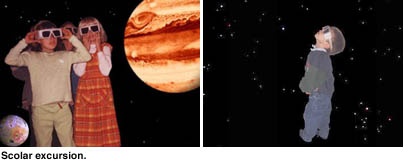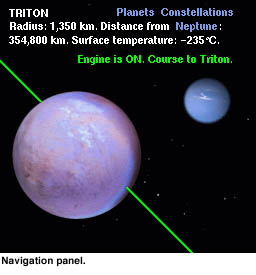

by Igor Nikitin and Stanislav Klimenko
At the Exhibition ZeitReise/TimeJourney from 12 May to 25 June 2000 at the Academy of Arts in Berlin, GMD’s Virtual Environments Group presented a 3D-installation ‘Virtual Planetarium’.

The Virtual Planetarium is an educational application that uses special methods to display the astronomical objects realistically, as they are visible by astronauts of a real spacecraft, preserving correct visible sizes of all objects for any viewpoint and using 3D models based on real astronomical data and images. The installation includes the 3200 brightest stars, 30 objects in the Solar System, an interactive map of constellations, composed of ancient drawings, a large database, describing astronomical objects textually and vocally in English and German. A stereoscopic projection system is used to create an illusion of open cosmic space. The application is destined primarily for CAVE-like virtual environment systems, giving a perception of complete immersion into the scene, and also works in simple installations using a single wall projection.
Avango Application Development Toolkit
Avango is a programming framework for building distributed, interactive virtual environment applications. It is based on a SGI Performer to achieve the maximum possible performance for an application and addresses the special needs involved in application development for virtual environments. Avango uses the C++ programming language to define the objects and scripting language Scheme to assemble them in a scene graph. Avango also introduces a dataflow graph, conceptually orthogonal to the scene graph, which is used to define interaction between the objects and to import the data from external devices into the application.
A non-linear geometrical model was used to represent the objects in the Solar System, overcoming a problem of ‘astronomical scales’. This problem consists in the fact that a size of the Solar System (diameter of Pluto orbit) and a sizes of small planets (Phobos, Deimos) differ by factor more than 109, as a result single precision 4 bytes real numbers, used in standard graphical hardware, are insufficient to represent the coordinates of objects in such a scene. A special non-linear transformation should intermediate the real scale astronomical model and its virtual analog, mapping astronomical double precision sizes ranging from 1 to 1010 km into virtual environment single precision sizes ranging from 1 to 20 m. Such transformation was chosen, satisfying two requirements: (1) it preserves actual angular sizes of planets for any viewpoint to achieve realism of presentation, (2) it prohibits penetration inside the planets to implement no-collision algorithm. Analogous transformations are also applied to the velocity of the observer, to make the exploration of near-Earth space and distant planets possible in one demo session.
 Navigation in CAVE is performed using electromagnetic 3D pointing device (stylus), or joystick/mouse in more simple installations. User can manipulate by a green ray in a virtual model, choosing the direction of motion and objects of interest. A navigation panel, emulating HTML browser, is used to display the information about selected objects and to choose the route of journey.
Navigation in CAVE is performed using electromagnetic 3D pointing device (stylus), or joystick/mouse in more simple installations. User can manipulate by a green ray in a virtual model, choosing the direction of motion and objects of interest. A navigation panel, emulating HTML browser, is used to display the information about selected objects and to choose the route of journey.
Sound accompaniment includes two musical themes, representing the rest state and fast motion, which are mixed dependently on the velocity (courtesy to Martin Gerke and Thomas Vogel), and voices, describing surrounding objects (courtesy to Christian Brückner and Ulrike Tzschöckell). Another variant of vocal representation is using the IBM ViaVoice text-to-speech conversion tool. The sound scheme can be selected and reconfigured during runtime.
Sources of planetary images and stellar data are from public Internet archives and databases available at the NASA: http://photojournal.jpl.nasa.gov, http://adc.gsfc.nasa.gov and US Geological Survey: http://wwwflag.wr.usgs.gov/. Images were imposed on a spherical geometry as textures and were enlightened by a composition of bright solar and dim ambient lights. Positions, intensities and colors of stars in the model correspond to astronomical data from catalogue. Additionally, high resolution images of constellations can be displayed in the sky. Source of images is an ancient stellar map: (Hemisphaerium coeli boreale/ Hemisphaerium coeli australe: in quo fixarum loca secundum eclipticae ductum ad an[n]um 1730 completum exhibentur/ a Ioh. Gabriele Doppelmaiero math. prof. publ. Acad. imper. leopoldino-carolinae naturae curiosorum et Acad. scient. regiae prussicae socio ; opera Ioh. Baptistae Homanni sac. caes. maj. geogra. – Norimbergae [Nürnberg]: [Homännische Erben], [erschienen 1742].), courtesy of Kaiserslautern University library.

Links:
http://heimat.de/zeitreise
http://viswiz.gmd.de/~nikitin/stars
Please contact:
Igor Nikitin - GMD
Tel: +49 2241 14 2137
E-mail: Igor.Nikitin@gmd.de